
The third USS Albany was a United States Navy protected cruiser of the New Orleans class. She saw service in the Philippine–American War and World War I.
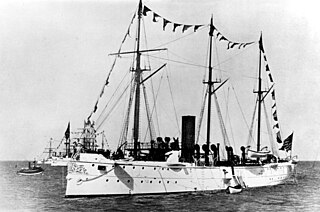
USS Bennington was a member of the Yorktown class of steel-hulled, twin-screw gunboats in the United States Navy in the late 19th and early 20th centuries. She was the first U.S. Navy ship named in honor of the town of Bennington, Vermont, site of the Battle of Bennington in the American Revolutionary War.

The first USS Wyoming of the United States Navy was a wooden-hulled screw sloop that fought on the Union side during the American Civil War. Sent to the Pacific Ocean to search for the CSS Alabama, Wyoming eventually came upon the shores of Japan and engaged Japanese land and sea forces. On 16 July 1863, Wyoming won the first-ever United States naval victory over Japan in the Battle of Shimonoseki Straits.

USS Yorktown was lead ship of her class of steel-hulled, twin-screw gunboats in the United States Navy in the late 19th and early 20th centuries. She was the second U.S. Navy ship named in honor of the American Revolutionary War's Battle of Yorktown.
The first USS Mohican was a steam sloop-of-war in the United States Navy during the American Civil War. She was named for the Mohican tribe and was the first ship of her class.

|} The first USS Tuscarora was a Mohican-class sloop of war in the United States Navy during the American Civil War. Tuscarora was laid down on 27 June 1861 at Philadelphia, Pennsylvania, by Merrick & Sons; launched on 24 August 1861; sponsored by Miss Margaret Lardner; and commissioned on 5 December 1861, Commander Tunis A. M. Craven in command.

The first USS Pocahontas, a screw steamer built at Medford, Massachusetts in 1852 as City of Boston, and purchased by the Navy at Boston, Massachusetts on 20 March 1855, was the first United States Navy ship to be named for Pocahontas, the Algonquian wife of Virginia colonist John Rolfe. She was originally commissioned as USS Despatch – the second U.S. Navy ship of that name – on 17 January 1856, with Lieutenant T. M. Crossan in command, and was recommissioned and renamed in 1860, seeing action in the American Civil War. As Pocahontas, one of her junior officers was Alfred Thayer Mahan, who would later achieve international fame as a military writer and theorist of naval power.
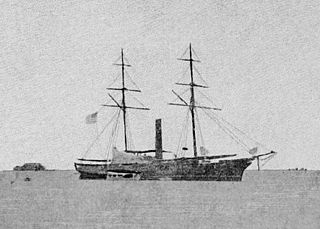
The first USS Saginaw was a sidewheel sloop-of-war in the United States Navy during the American Civil War. The ship was in operation throughout the 1860s, but in 1870 wrecked on what is now known as Kure Atoll, a Pacific island. The event produced several books and one of the surviving boats from the ship is in a museum.

The second USS Vandalia was a screw sloop-of-war in the United States Navy. She was laid down at the Massachusetts Boston Navy Yard in 1872 and was commissioned there on 10 January 1876.
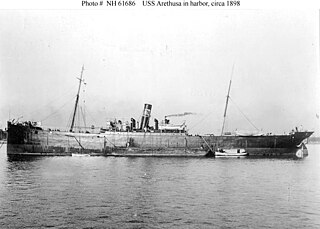
USS Arethusa (AO-7) was a steamship that was built in England in 1893 as the civilian oil tanker Luciline. The United States Navy bought her in 1898, and later had her converted into a Fleet oiler. She was sold back into civilian ownership in 1927,and by 1928 she was a civilian hulk in Boston.

The first USS Annapolis (PG-10/IX-1) was a gunboat in the United States Navy. She was named for Annapolis, Maryland.

The second USS Mohican was a steam sloop of war in the United States Navy. She was named for the Mohican tribe.

USS Nipsic was a gunboat in the Union Navy. The ship was laid down on 24 December 1862 by Portsmouth Navy Yard; launched on 15 June 1863; sponsored by Miss Rebecca Scott; and commissioned on 2 September 1863, Lieutenant Commander George Bacon in command.

USS Wheeling (PG-14) was a Wheeling-class gunboat acquired by the U.S. Navy in 1897. She served as a gunboat during the Spanish–American War as well as a convoy escort during World War I. As IX-28 she also served as a schoolship for the training of Naval Reservists, and, at the end of World War II, just before being struck from the Navy records, she was temporarily assigned as a barracks ship for torpedo boat crews.

USS Brutus, formerly the steamer Peter Jebsen, was a collier in the United States Navy. She was built in 1894 at South Shields-on-Tyne, England, by John Readhead & Sons and was acquired by the U.S. Navy early in 1898 from L. F. Chapman & Company. She was renamed Brutus and commissioned at the Mare Island Navy Yard on 27 May 1898, with Lieutenant Vincendon L. Cottman, commanding officer and Lieutenant Randolph H. Miner, executive officer.

USS Hancock (AP-3) was a transport ship in the United States Navy. Acquired by the Navy in 1902, she participated in World War I and a number of US military and diplomatic ventures prior to that. She was named for Founding Father John Hancock.
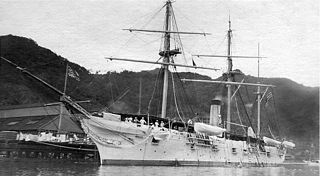
USS Adams was a screw gunboat and the lead ship of the Adams class. She was named for Founding Father and second president of the United States John Adams.
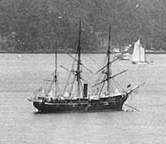
As part of the Secretary of the Navy George M. Robeson's plans to overhaul and modernize ships of the Navy, the first USS Swatara was taken to the New York Navy Yard in 1872, ostensibly for "repairs". In fact, the "repairs" constituted construction of a new ship, for Swatara was given a new hull and unused machinery which had been in storage since 1865. Embodying only certain fittings and equipment from the first ship, the second Swatara was launched on 17 September 1873 at the New York Navy Yard and commissioned on 11 May 1874, Capt. Ralph Chandler in command.

The first USS Thetis was a three-masted, wooden-hulled steam whaler in the United States Navy used to rescue a polar expedition and later in the Revenue Cutter Service.

USS Nero (AC–17), a steel steam collier, was launched in 1894 as the steamer Whitgift by J.L. Thompson and Sons, Sunderland, England. The vessel was purchased on 30 June 1898 from McCondray and Co. at San Francisco and commissioned on 8 June 1898.



















